ISSN ONLINE(2278-8875) PRINT (2320-3765)
ISSN ONLINE(2278-8875) PRINT (2320-3765)
Poonam Nagumalli1, Miss .P .Suguna Ratnamala2
|
| Related article at Pubmed, Scholar Google |
Visit for more related articles at International Journal of Advanced Research in Electrical, Electronics and Instrumentation Engineering
The paper is mainly about the manipulation of a single phase shunt active filter based on instantaneous power theory. The active filter in used mainly used for the suppression of harmonics. P-Q theory also known as instantaneous power theory but here it is implemented for a single phase by producing the dummy signals with 120 â° phase shift as an input to the p-q theory. This will generate the PWM signal for switching IGBT of the inverter. Hence it produces the active filter current used to reduce the THD at the load current. The simulation results are on the MATLAB (SIMULINK) environment tool presented in order to demonstrate the performance of the current load on a single phase shunt active power filter.
INTRODUCTION |
| There is an increasing demand demand for power electronic devices for ex : power converters and other loads (non linear). By generating the harmonic that came from non linear loads will be facing a serious problem in the power system such as power factor factor is low, losses increase, and efficiency reduction. Hence there is an increase in the total harmonic distortion The theory also known as p-q theory or instantaneous power theory introduced by Akagi , Nabae and Kanazawa in 1983 [1] [2] , The p-q theory was introduced and implemented for three phase system. As shown in fig.1. Based on the term for P and Q the p-q theory will manipulate the two types of power that is the active and reactive power so that there could be maintained a sinusoidal wave form of current at load end of the three face supply. |
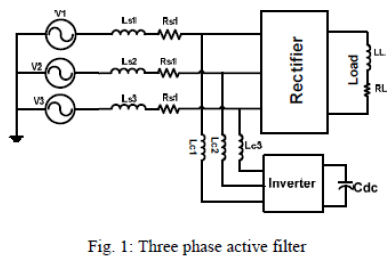 |
| Few other techniques are also used to eliminate harmonics like the harmonic filters apart from the active filter such as LC- filters and zigzag filters. The above techniques had many disadvantage such as the possible resonance, fixed compensation, Voltage sag and flickers.[1,2] , electromagnetic interference and bulkiness. |
| There are certain advantages of using a shunt active power filter for a single phase grid as it can be installed anywhere which use single phase power system. The aim of this paper is to implement the p-q theory in a single phase shunt active filter connected directly to the grid power system. This is done by using a simulink environment. |
MATHEMATICAL MODELLING |
| The P-Q theory also known as the instantaneous power theory. is used for a three phase power system. That is both three wire and four wire system. This theory use three currents and three voltages, it can also be used for a single phase active filter by using two more currents and voltages. Signals with 120° angle shifting. This theory based on separation of power component separation in the mean and oscillating values. Consider the load current of a single phase load with a phase ‘a’ and the two dummy phases ‘b’ and ‘c’ are generated by the duplicating technique. The load current is considered to be phase ‘a’ and is expressed mathematically as in eq(1) and the phase currents for phase ‘b’ and ‘c’ can be given by the equations eq(2) and eq(3) |
 |
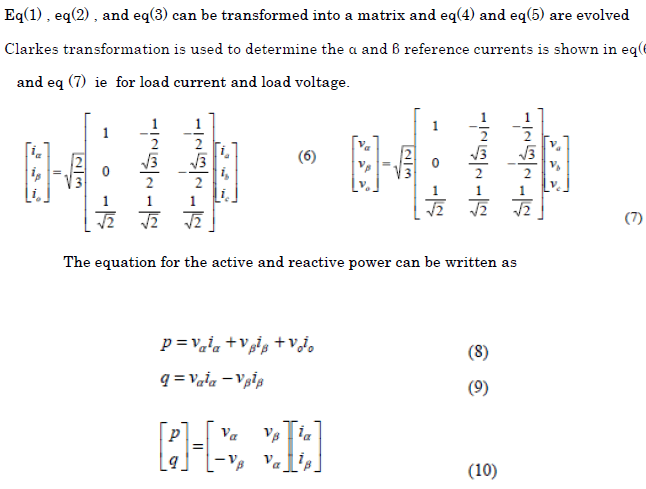 |
| The birth parts that is the active and reactive parts have both the AC (oscillating) and the DC (mean) part. |
| The equation for active and reactive power can be given as |
 |
| The AC part can be calculated using a high pass filter which can remove the low frequency and give the fundamental component ac part from which the (α-β) reference currents can be calculated |
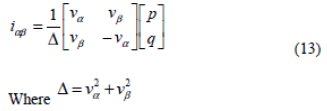 |
| Therefore the active power filter three phase reference currents can be calculated using equation (14) .These are calculated by using the difference between. |
| The PWM signal will be generated by using Hysteresis current control .The hysteresis band will generate six PWM signal but for single phase it is only two that are used for as an input to the inverter. |
 |
SINGLE PHASE SHUNT ACTIVE FILTER |
| A single phase shunt active filter filter consists of a supply utility a rectifier bridge, inverter and LCL filter , hysteresis current controller and load. A 1-Φ shunt active filter is shown in figure 2. The active power filters can be classified into two types namely Current source where the storage element is a inductor and voltage source active power filter where the storage element is capacitor. The only difference between these two topology is storage element. |
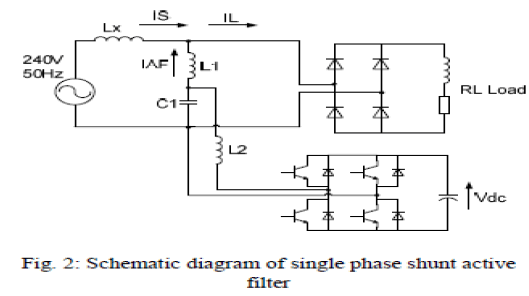 |
| Fig:3 shows control strategy based on p-q theory which generates the PWM signals for single phase shunt active filter utilizes the below control strategy on SIMULINK |
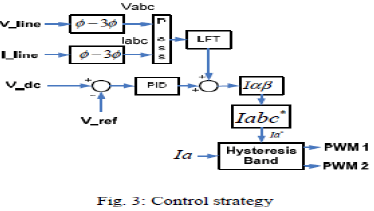 |
SIMULATION RESULTS |
| A single phase shunt active filter is simulated using MATLAB. It uses a single phase system 100 v, 50 Hz directly from the TNB as shown in figure 4. A non linear load for compensation is implemented infront of a diode rectifier. |
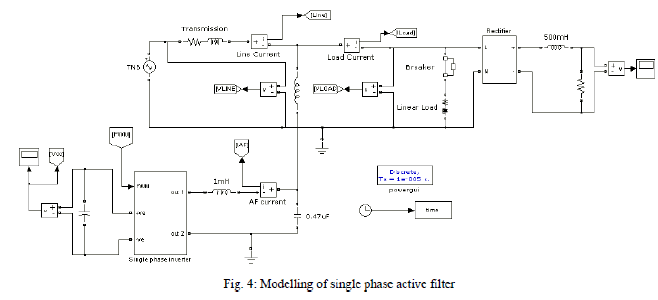 |
| Fig .5 It is the modeling of P-Q theory which consists of single phase to two phase and two phase to three phase transformations and hysteresis band. Single phase shunt active filter produces six PWM signals out of which only two are used to control the single phase active filter. |
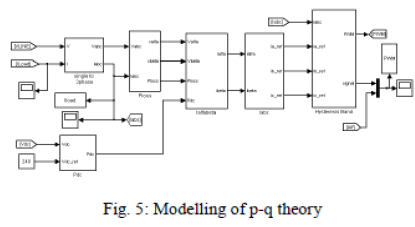 |
| Fig 6 represents the current response of a single phase shunt active filter. The switching PWM signal , the active filter current are shown in figure .7, fig 8 represents the load current will be compensated by injecting active filter current in fig:9 hence the line current is maintained a pure sinusoidal as shown in fig 10, Fig 11 shows the three phase load current that will be used for p-q theory applications. |
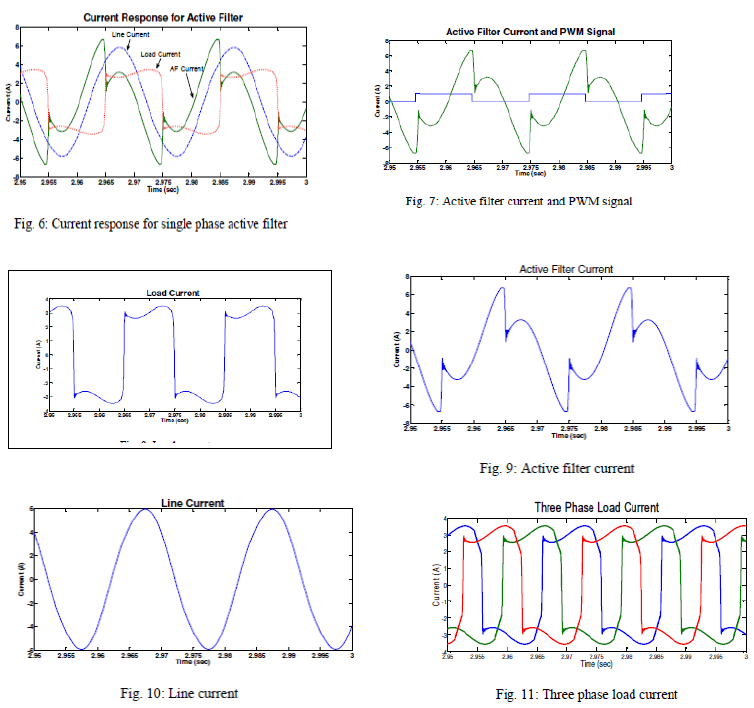 |
 |
CONCLUSION |
| There is an increasing demand for the non linear loads and facing of harmonic and power factor problems in power system. There are many techniques or topologies can be used to eliminate harmonic from power system. One of the methods is active power filter. Hence it proves that the instantaneous power theory is implemented so that it controls the single phase shunt active filter where this was inherently a three face theory. Hence its concluded that by implementing p-q theory the THD of the load current can be reduced from 44.92% to 2.85%. |
References |
|